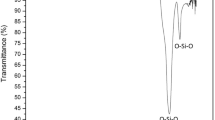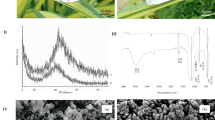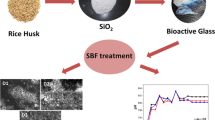Abstract
Rice husk ash has been used to prepare amorphous silica bioactive ceramics. Three varieties of silica powders, namely brown ash, white ash and silica gel containing 96.0, 99.8 and 99.9% silica respectively, were used to prepare silica ceramics. The bioactivity and biodegradability properties of these ceramics were evaluated. The formation of crystalline apatite was observed on all the specimens in simulated body fluid. The phase composition, morphology and calcium/phosphorous ratio of the apatite layer formed were evaluated by X-ray Diffraction, Scanning Electron Microscopy and Energy Dispersive Spectroscopy. Controlled biodegradability of amorphous silica in Tris buffer solution was found. These results suggest that the amorphous silica derived from rice husk ash is a promising and cost effective biomaterial.
Similar content being viewed by others
References
Hench LL (1996) In: Ratner BD, Hoffman AS, Schoen FJ, Lemons JE (eds) An introduction to materials in medicine. Academic Press, USA
Ryu HS, Seo JH, Kim H, Hong KS, Park HJ, Kim DJ, Lee JH, Lee DH, Chang BS, Lee CK (2002) Key Eng Mater 15:261–265
Lafon JP, Champion E, Bernache-Assolant D (2002) Key Eng Mater 15:477–481
Ogose A, Kondo N, Umezu H, Hotta T, Kawashima H, Tokunaga K (2006) Biomaterials 27:1542
Liu X, Ding C, Wang Z (2001) Biomaterials 22:2007–2012
Nagata F, Miyajima T, Yokogawa Y (2003) Key Eng Mater 240:167–170
Kokubo T (2005) Mater Sci Eng C 25:97–104
Kortesuo P, Ahola M, Karlson S, Kangasniemi I, Yli-Urpo A, Kiesvaara J (2000) Biomaterials 21:193–208
Barbe C, Bartlett J, Kong LG, Finnie K, Lin HQ, Larkin M (2004) Adv Mater 16:1959–1966
Kobayashi M, Nakamura T, Okada Y, Fukumomo A, Furukawa T, Kato H (1998) J Biomed Mater Res 42:223–237
Oonishi H, Hench LL, Wilson J, Sugihara F, Tsuji E, Matsuura M (2000) J Biomed Mater Res 51:37–46
Ferrer ML, Garcia-Carvajal ZY, Yuste L, Rojo F, del Monte F (2006) Chem Mater 18:1458–1463
Hamad MA, Khattab IA (1981) Thermochim Acta 48:343–347
Nayak JP, Bera J (2009) Phase Transit 82:879–888
Asuncion MZ, Hasegawa I, Kampfa JW, Laine RM (2005) J Mater Chem 15:2114–2121
Bansal V, Ahmad A, Sastry M (2006) J Am Chem Soc 128:14059–14066
Krishnarao RV, Godkhindi MM, Chakraborty M, Mukunda PG (1991) J Am Ceram Soc 74:2869–2872
Sarangi M (2009) Silicon 1:103–109
Cüneyt Tas A (2000) Biomaterials 21:1429–1438
Nieto A, Areva S, Wilson T, Viitala R, Vallet-Regi M (2009) Acta Biomater 5(9):3478–3487
Koch OG, Koch-Dedic GA (1974) Siliconmolybdanblau-Verfahren. In: Handbuch der Spurenanalyse. Berlin: Springer-Verlag: 1105
Balamurugan A, Balossier G, Kannan S, Michel J, Rebelo AHS, Ferreira JMF (2007) Acta Biomaterialia 3:255–262
Sacks MD, Scheiffele GW (1985) Ceram Eng Sci Proc 6:1109–1123
Lluch AV, Ferrer G, Pradas M (2009) Polymer 50:2874–2884
Author information
Authors and Affiliations
Corresponding author
Rights and permissions
About this article
Cite this article
Nayak, J.P., Bera, J. Bioactivity Characterization of Amorphous Silica Ceramics Derived from Rice Husk Ash. Silicon 4, 57–60 (2012). https://doi.org/10.1007/s12633-010-9058-3
Received:
Accepted:
Published:
Issue Date:
DOI: https://doi.org/10.1007/s12633-010-9058-3




